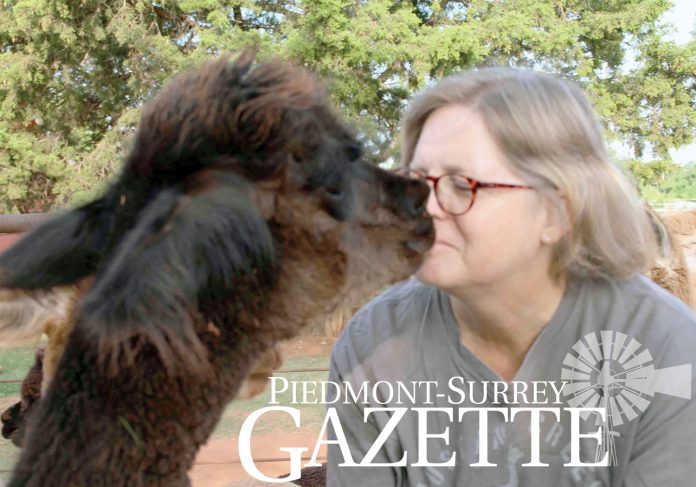By Carol Mowdy Bond
Contributing Writer
Owners of the Mustang Creek Alpaca Company in Canadian County, Kathy and Mike Fleming use alpaca fleece to make alpaca products they sell. But the pandemic has pulled the rug out from under their business.
Kathy said, “The pandemic has hurt us. All the shows and festivals and the Oklahoma State Fair have been closed down. This would have been our 10th year at the state fair. We always do an educational display that shows the process from alpaca to finished product. And we sold our products.”
While on a trip years ago, Kathy and Mike fell in love with alpacas. So, they purchased a six acre Canadian County horse farm, complete with a barn and horse stalls. And 10 years ago they started buying the Peruvian beauties.
Raising alpacas turned out to be a great hobby for the Flemings. Kathy said, “It’s so peaceful out here. It’s only a hobby farm. But this is a hobby that takes up a lot of my time. To make it a full time job, you need a lot of animals.”
“We have a good mentor,” Kathy said. “He was from a 400 pack alpaca farm in another state, and he knows genetics.”
A lot of people confuse llamas with alpacas. Llamas are pack and guard animals. In fact, you’ll find them guarding livestock in Canadian County. But alpacas are bred for their fiber to make clothing. As well, alpacas are smaller than llamas.
There are two breeds of alpacas. One is the huacaya, which is the fluffier and fuzzier of the two. All the Fleming alpacas are huacayas. The other breed, the suri, has dreadlock-type fleece.
Alpacas make certain noises for specific purposes. And they’re herd animals that take care of their own. “There’s a leader in each group that looks out for things,” Kathy said. “And they have a caution squeal they make if there’s a problem. Then they decide if they’ll run, or go after the predator.”
When going into the barn, the Fleming alpacas know and go to their own stalls. They also know to eat from their own, personal, feed buckets in their stalls.
It’s hot outside now. But, Kathy said, “We have low profile sprinklers in the field. When it’s hot, we turn those on. They spray the animals’ bellies, and then the animals go into the barn and lay down in front of the fans to stay cool.”
And these alpacas are well fed. They have hay as well as alpaca feed. The Flemings keep their feed in a freezer, so the mice will leave it alone. During warm months, they leave the hay bales in the fields. But during winter, they have hay feeders inside the barn so the alpacas aren’t munching outside in the cold weather.
FLEECE AND KOOL-AID
Kathy said, “Our animal fleece makes a nice product. Primarily we dye our fleece with Kool-Aid. But we also send our fleece to mills, and they dye our yarn. We send the fleece to places in the U.S. to make the yarn, and also to make the alpaca socks. We try to support other small U.S. businesses. But we do have to import some items from Peru, such as stuffed animals.”
Just like wheat harvesters who seasonally travel through areas to harvest wheat, there are teams of shearers who travel. After they shear the alpacas, Kathy has a routine for working with the fleece. “Alpacas roll in the dirt,” Kathy said. “So, their fleece is full of dirt and all kinds of things. After sheering, I take the fleece and put it in a tumbler before I do anything else. A lot of the dirt falls out. Then I sort the fleece by size, etc. If I send it to the mill, I vacuum pack it and ship it. If I keep the fleece, I wash and dry it here. I put the fleece in a tub to soak, and I use Dawn dish soap. Then I dry it by putting it on old screen doors until it dries. I put the screens on saw horses.”

ALPACA YOUR SOCKS WHEN YOU TRAVEL
The Flemings sell an assortment of items made from their alpaca fleece, including socks, winter head bands, coasters including car coasters, and more. Currently they’re selling their products online, and at Showplace Market, 2001 S. Broadway Avenue in Moore, and Feathered Nest Market, 6353 N. MacArthur Boulevard in Warr Acres.
“I knit and crochet quite a few things that we sell,” Kathy said.
“We’ve made alpaca jerky and summer sausage in the past. And we make and sell a lot of dryer balls.”
Kathy uses the short or course fibers, that can’t be used for anything else, to make pin cushions. “Alpaca fleece doesn’t have lanolin in it, so it doesn’t sharpen the pins like sheep wool does. So, I combine the alpaca fleece with sheep wool. And I use rice to give the pin cushions weight.”
ALPACA POO- WHO KNEW?
It’s hard to believe, but the Flemings also sell alpaca poo.
And yes, you read that correctly. It’s great for blending into potting soil and garden soil. “It’s not a hot manure,” Kathy said. “So, you can put it right onto plants. And it doesn’t stink like cow manure. We clean up the poop daily. It helps with the parasite issue. We have a pasture vac, and it grinds it. So we vacuum and sell it ground.”
The Flemings have raised flower and vegetable beds on their farm. “We have no dirt in them,” Kathy said. “We just have alpaca poo and hay in the beds.”
BLUEBONNET FEEDS
“We are the Bluebonnet Feeds distributor in the Oklahoma City metro area,” Kathy said.
“We take orders, and then pick up the orders at their plant, and then we dispense the feed.”
To shop online or connect with the Mustang Creek Alpaca Company go to www.MustangCreekAlpacas.com, or email info@MustangCreekAlpacas.com.






